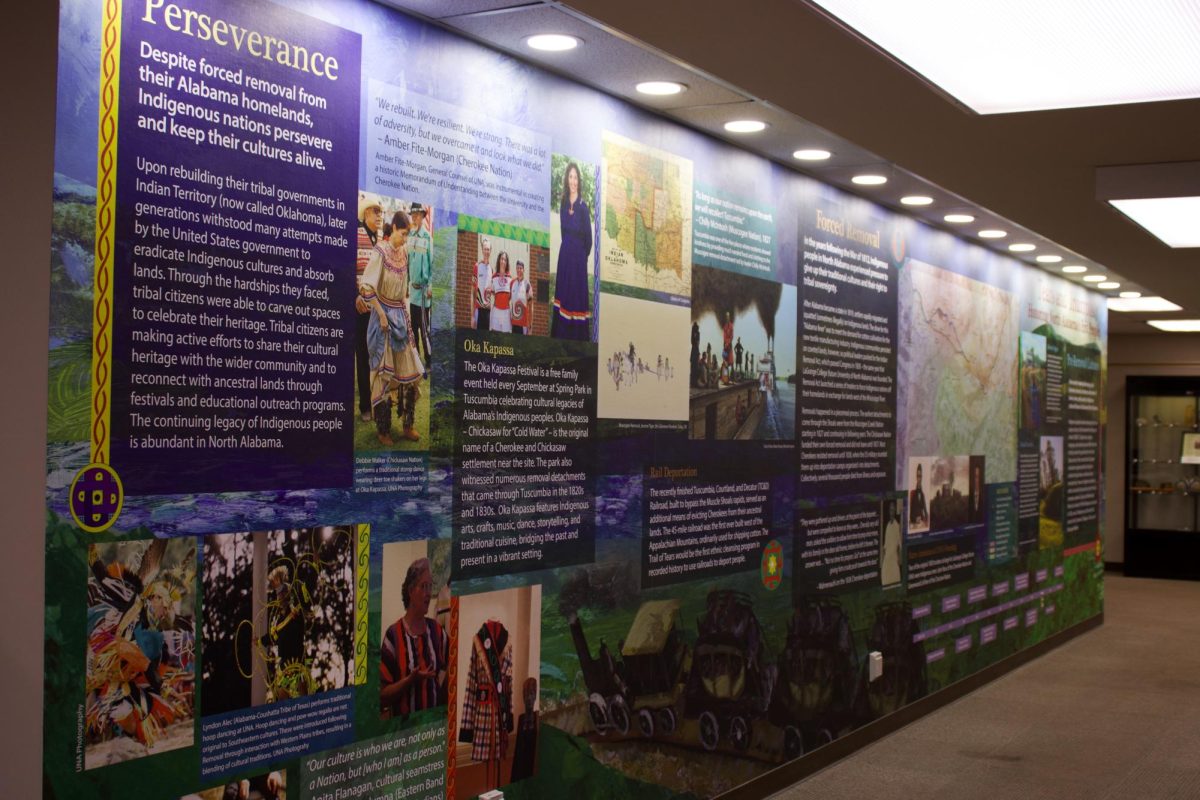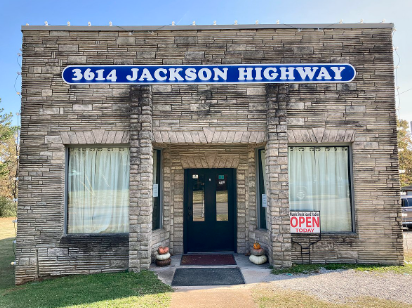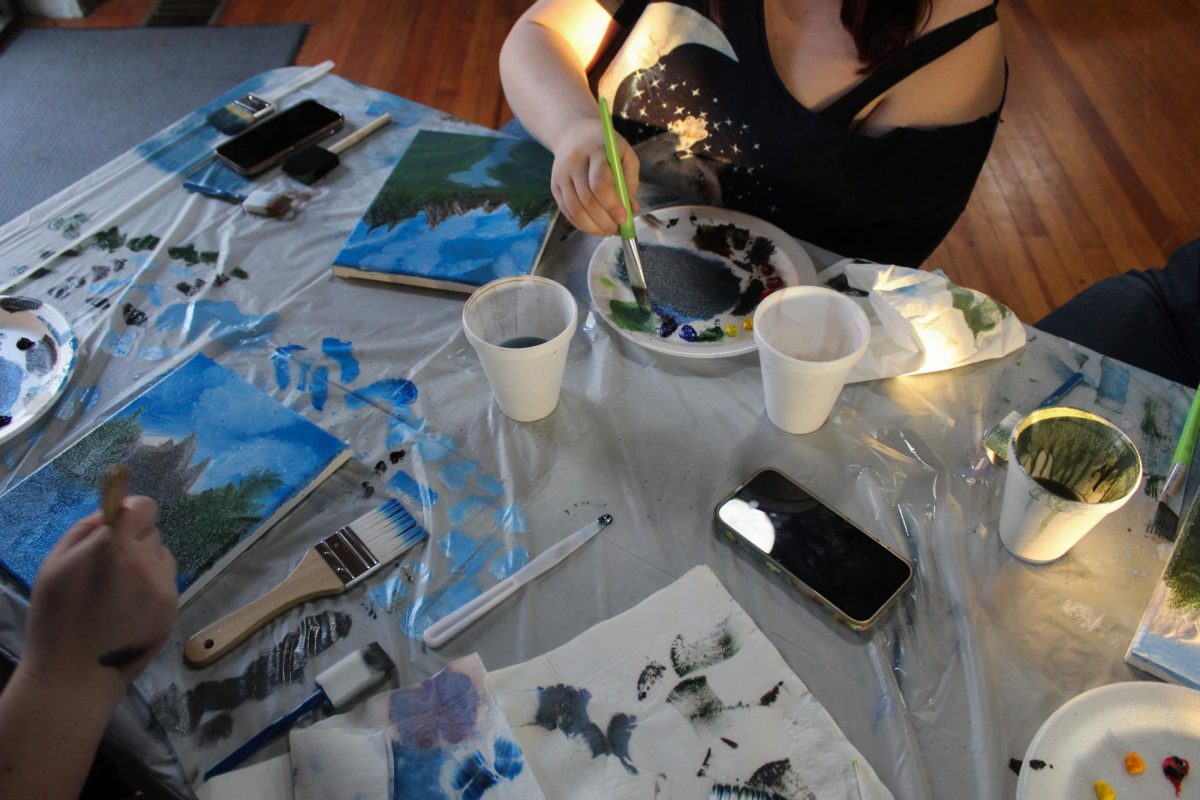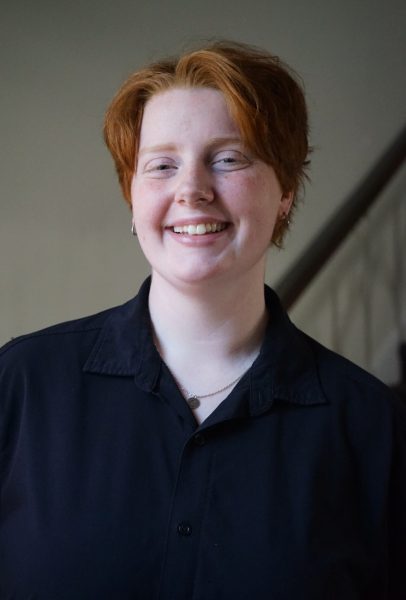The University of North Alabama’s Collier Library held a ceremony to reveal their new mural, which honors the history and future of local Native American peoples.
The unveiling took place on Sep. 12 on the first floor of Collier Library, with attendees from the student body, UNA’s faculty and staff and the Shoals community.
The mural can be viewed on the wall facing Caffe Dallucci, taking the place of previous murals, which honored the life and legacy of Dr. Wendell Gunn and The Year of the UNA Woman. The new art, titled “Tears and Triumphs: Honoring North Alabama’s First Peoples,” tells viewers of the history of indigenous groups who occupied territory on or around UNA’s campus. The wall functions as a timeline, walking its audience through pre-removal cultures and forced removal, and it includes facts about important leaders and events throughout their histories. At the end of the timeline, viewers land on a section titled “Perseverance,” pointing to the resilience of the Native American populations the mural honors and providing hope for their future.
Along with the information presented on the mural, the project also includes information plaques on the columns by the mural, which provide further historical context. In addition to this, there are also mannequins displaying replicas of traditional cultural clothing from Native American populations, as well as a display case of artifacts from indigenous groups who lived in this area. With all of the information presented, the mural functions as an exhibit that library visitors can consult for more information about North Alabama’s first peoples.
The newest addition to Collier Library was created as a collaboration between students from the Department of History and the Department of Visual Arts and Design. The collaboration offered experiential learning opportunities to the students who participated, and the project has created a symbol of the history of the Shoals area’s first peoples for others to enjoy and learn from.
Other stakeholders in the project include members of the Alabama Trail of Tears Association, board members of the National Trail of Tears Association, the Chickasaw Nation Department of Culture and Humanities, the Cherokee Nation, Cherokee Nation businesses and the Muscle Shoals National Heritage Area.
The program opened with children from the fourth grade at Kilby Laboratory School, who studied land acknowledgments for the area and presented their own land acknowledgments.
“We acknowledge that where we are standing is important and sacred,” said the students. “The University of North Alabama, including our Kilby Laboratory School, is built upon Cherokee and Chickasaw traditional homelands which were unrightfully taken away. We understand and appreciate the care that their indigenous ancestors have taken of the land, water, air, animals and plants so that we have the Earth to enjoy today. We respect these tribal nations for taking care of our shared Earth and allowing us to learn from their connection to nature. Wado, which means ‘thank you’ in Cherokee.”
After their acknowledgement of the land, Dr. Sean Jacobson, an assistant professor of history at UNA and the project director for the mural, expressed his thanks and introduced the message of the mural.
“Today we celebrate the unveiling of a mural that beautifully captures the rich history and heritage of North Alabama’s first peoples,” said Jacobson. “This completed work and the accompanying exhibit stand as a tribute to the enduring legacy of the indigenous peoples who first called this place home, long before the University of North Alabama was here. It serves as a powerful reminder of the deep connections we all share with this land.”
With UNA’s bicentennial approaching in 2030, Jacobson acknowledged that two of LaGrange College’s first trustees were Native American men, as one of the mural’s panels illustrates. Jacobson then connected this fact to the passage of the Indian Removal Act in 1830, the same year as LaGrange College’s founding, and the unjust removal of the indigenous peoples of this area.
“As the mural’s title ‘Tears and Triumphs’ indicates, our purpose in acknowledging this tragic part in our nation’s history is not to accuse or shame anyone,” Jacobson said. “Rather, we commemorate and honor the ways that North Alabama’s first peoples have persevered amid hardship and persecution, and continue to contribute to this region’s diverse cultural heritage landscape. Today, more than ever, native people are eager to rekindle connections with the ancestral homelands and educate the wider public on the accurate portrayal of their histories and their communities. We offer this mural today as a token of friendship and goodwill to our stakeholders. We also hope that this mural can serve as a place of reflection and inspiration in cultivating these friendships.”
One of the friendships Jacobson mentioned is evident between UNA and the Cherokee Nation, as was expounded upon firstly by University President Dr. Kenneth Kitts and secondly by Principal Chief of the Cherokee Nation Chuck Hoskin Jr.
“Today, in classrooms across our campus, professors are teaching students about the importance of context,” said Kitts. “They’re teaching about how the past shapes our present and informs our thinking about the future. They’re teaching about relationships that extend across time and space. We hope that our students take these lessons to heart… The best way we can make these lessons live through our students is through leading by example. With that in mind, this mural underscores our commitment to doing just that. By acknowledging and celebrating those who came before us on the land that gave rise to LaGrange College and eventually UNA, we signal our appreciation for context and our deep respect for those who loved this land first, and who blessed it with their careful labor and their careful stewardship of resources… Let’s be proud of this beautiful, modern, historically important, dynamic university, but let’s always temper that pride with humility and respect for those first peoples of North Alabama who came before us and paved the way for the success that we enjoy today.”
Hoskin followed Kitts by speaking about the importance of the relationship between UNA and the indigenous groups of this area. To Hoskin, the mural symbolizes both the grit and determination of Native American populations and the necessity of those who have stood behind those populations through their unjust mistreatment.
“There’s a fair amount of division in this country,” said Hoskin. “There’s a lot of ways we can be unified. That story of Cherokee endurance, that story that means that an elected Chief of the Cherokee Nation can even be on this great campus today, was written not only because we were people of grit and determination who picked ourselves up when we were knocked down, but we did it also because we had friends… All of those friendships helped to build something up in our national character that filled us with strength so that we could endure. When I talk to young Cherokees about their place in the world, where they come from, why they matter and why they can be anything, it’s not just because their people are so tough, so stubborn, so willing to do whatever they have to do to survive. It’s not just because they had the audacity to survive against great odds. They had the sense to make friends.”
The mural and its accompanying exhibits are open to any on UNA’s campus who wish to understand more about this area’s history.








